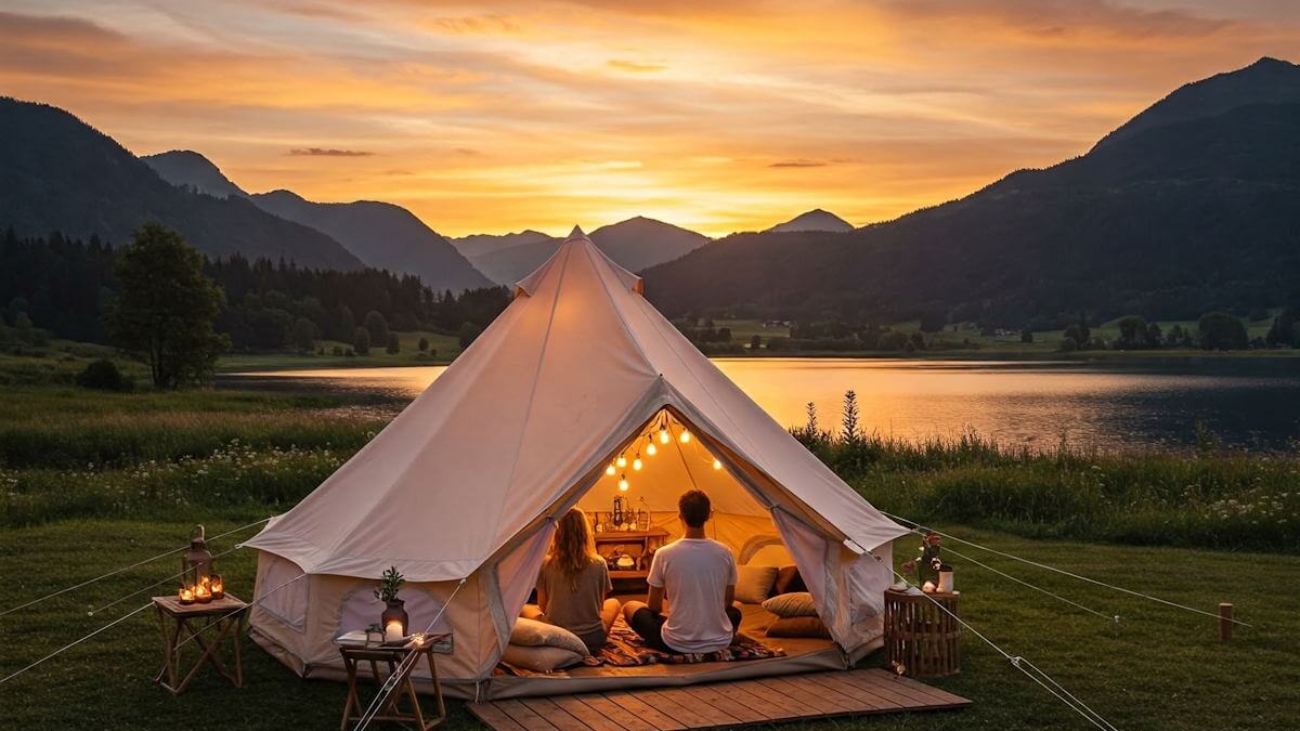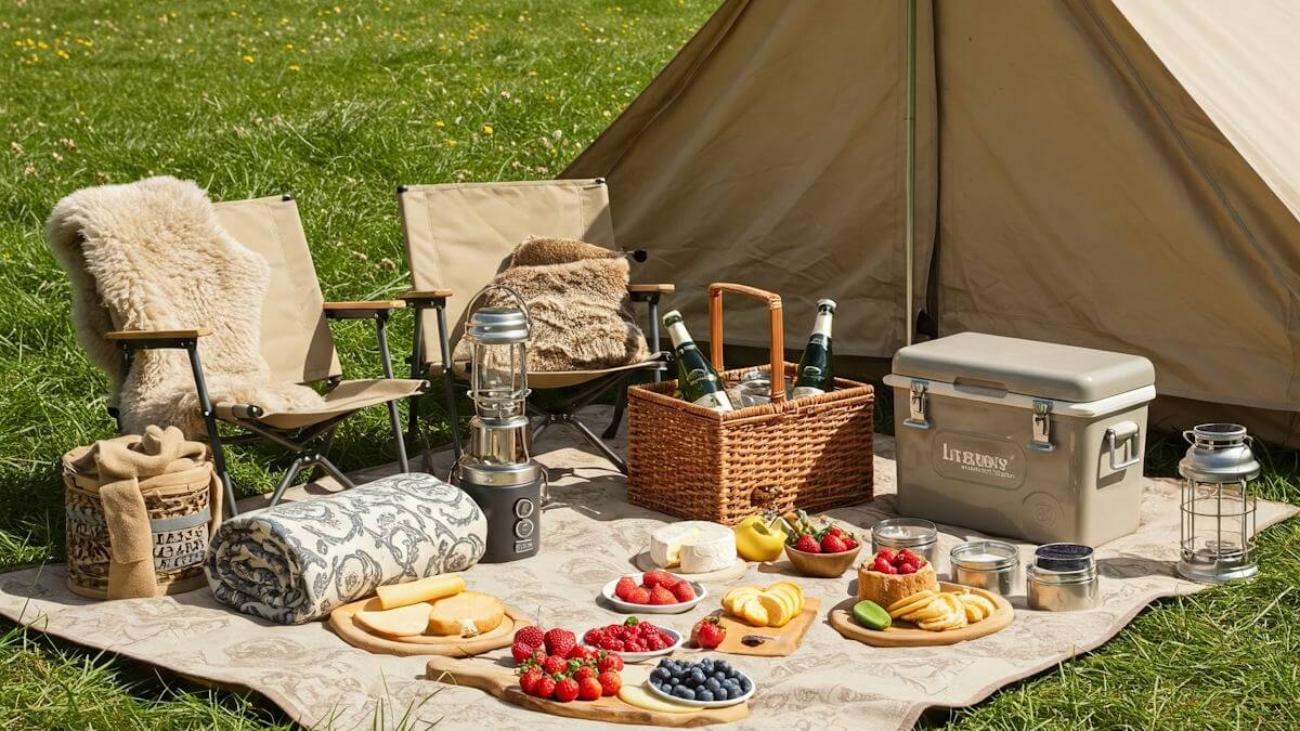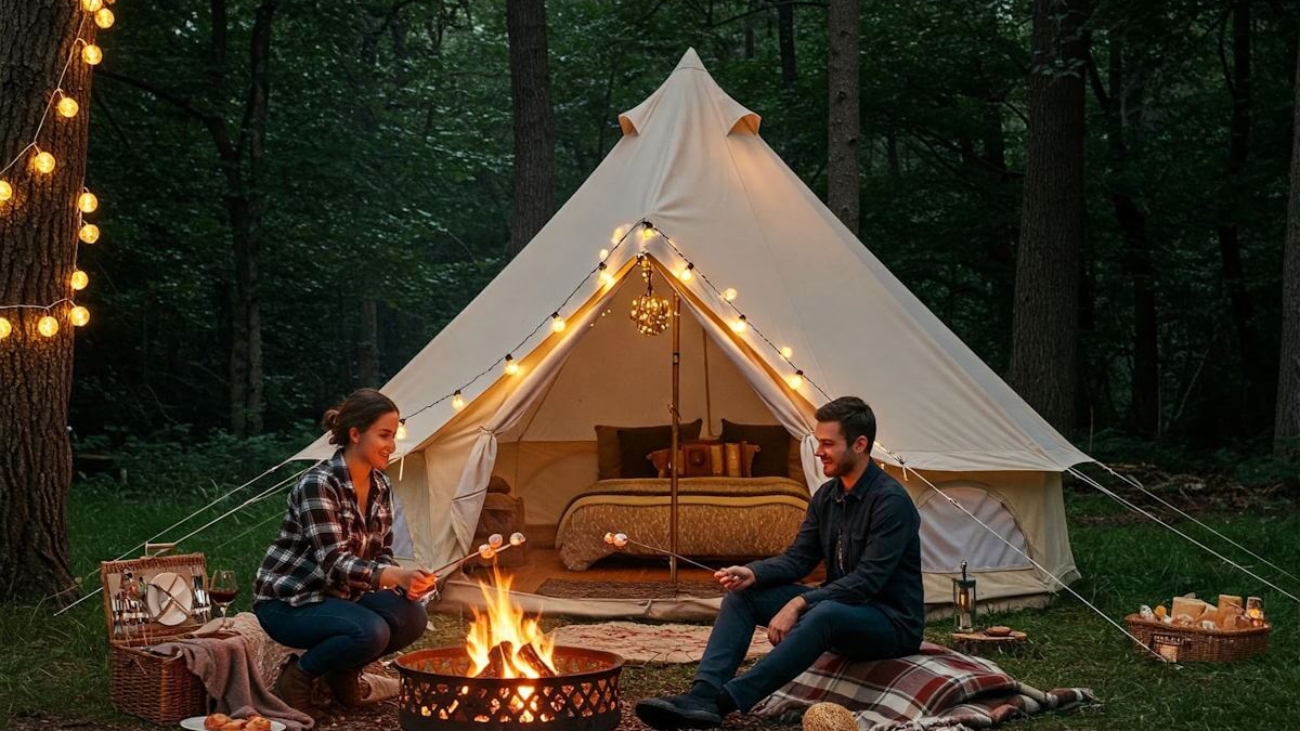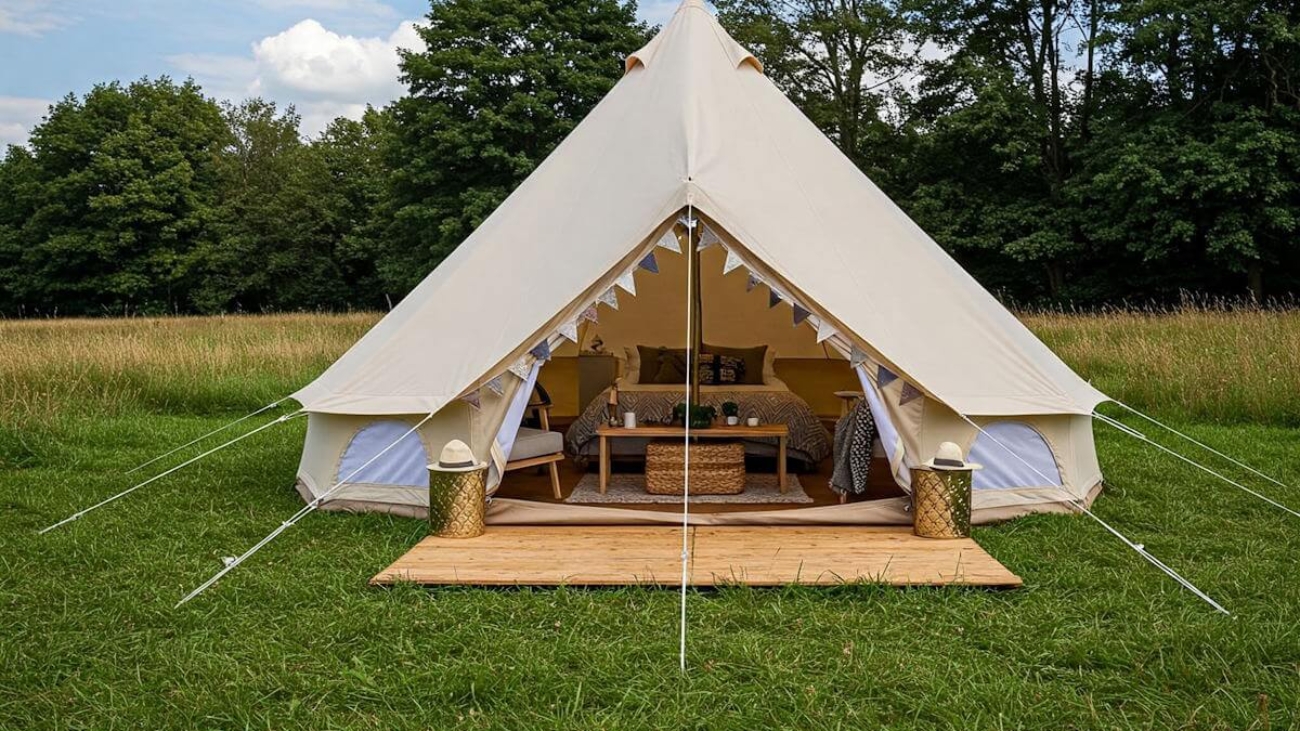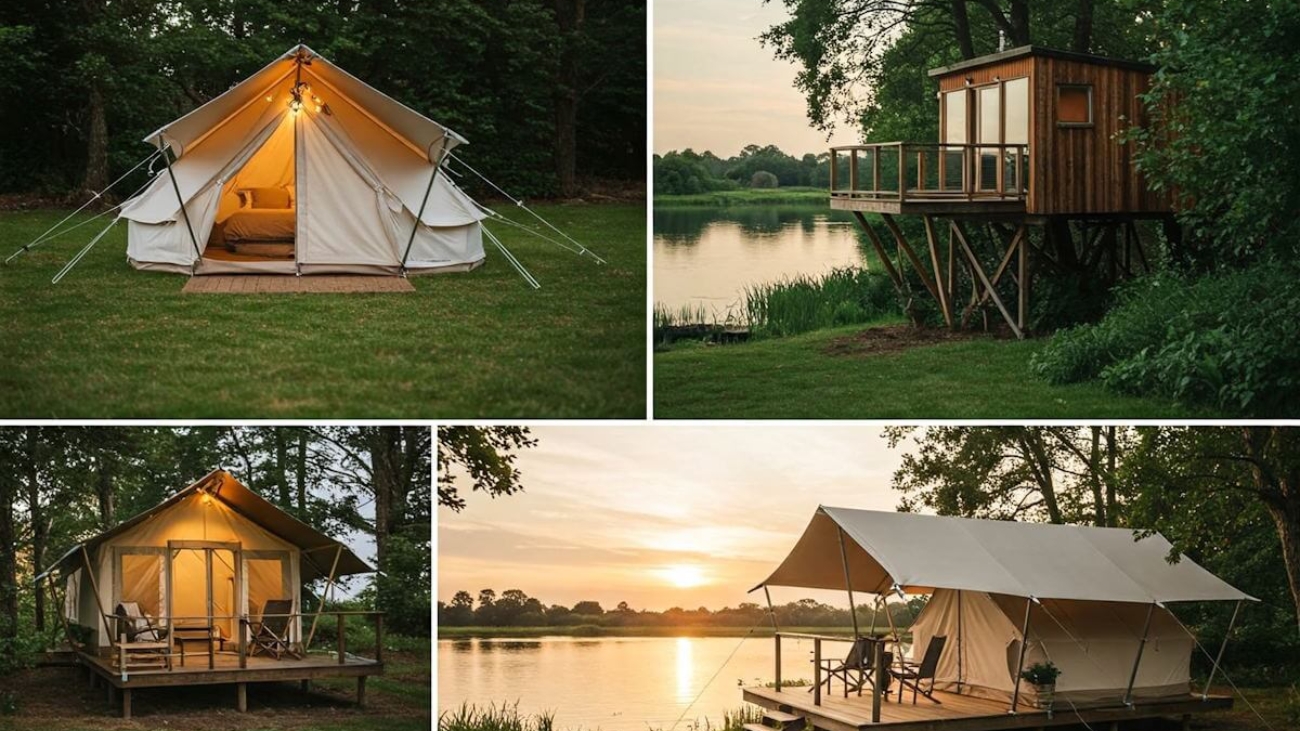Glamping, a portmanteau of “glamorous” and “camping,” has rapidly gained traction as a contemporary alternative to traditional camping, appealing to a wide array of outdoor enthusiasts and luxury seekers alike. Unlike the typical camping experience, which often requires individuals to sacrifice comfort for nature, glamping seamlessly integrates lavish amenities with the great outdoors, creating a unique and enriching experience.
This luxurious form of camping allows individuals to enjoy the beauty of nature without the inconveniences commonly associated with standard camping, such as sleeping on hard ground, dealing with harsh weather conditions, and preparing meals over an open flame. With glamping, accommodations can range from elegantly designed yurts and safari tents to fully equipped cabins and treehouses, each providing a comfortable and stylish environment. These spaces often come equipped with plush beds, electricity, running water, and even gourmet dining options, elevating the outdoor experience to one of indulgence and ease.
The rising popularity of glamping can be attributed to the growing desire for individuals to reconnect with nature while retaining access to modern comforts. As people become increasingly aware of the mental health benefits associated with spending time outdoors, glamping serves as an appealing option for those looking to unwind and escape the fast-paced demands of urban life. By facilitating a deeper connection to the natural world, glamping encourages not only relaxation but also introspection and mindfulness. This phenomenon underscores the ability of luxurious outdoor experiences to not only satisfy the desire for adventure but also promote well-being through thoughtful engagement with one’s surroundings.
The Concept of Mindfulness
Mindfulness, rooted in ancient meditation traditions, particularly within Buddhism, has gained widespread recognition in contemporary society as an essential practice for mental well-being. At its core, mindfulness involves the intentional focus on the present moment, fostering awareness of one’s thoughts, feelings, and sensations without judgment. This practice is aimed at cultivating a deeper connection with oneself and the environment, allowing individuals to cultivate a sense of peace even amidst the chaos of daily life.
One of the fundamental principles of mindfulness is to observe thoughts and feelings as they arise, promoting a non-reactive stance towards them. Such an approach encourages individuals to let go of distractions and habitual responses, enabling a richer, more immersive experience of life. The practice can be as simple as taking a few deep breaths in nature, observing the sights and sounds around, or engaging in a guided meditation designed to hone attention on the here and now.
Numerous benefits of mindfulness have been documented through research, particularly its positive effects on mental clarity and emotional health. Regularly engaging in mindfulness practices has been shown to reduce symptoms of anxiety and depression, enhance cognitive flexibility, and improve overall emotional resilience. Moreover, by encouraging individuals to remain present, mindfulness fosters gratitude and appreciation for everyday experiences, thereby enriching one’s quality of life.
Through activities such as glamping, where individuals immerse themselves in nature and disconnect from the constant stimuli of modern technology, mindfulness can be seamlessly integrated into daily routines. This connection with the environment not only enhances mindfulness practices but also serves as a catalyst for personal growth, helping individuals to deepen their understanding of themselves and their interactions with the world around them.
Why Combine Glamping with Mindfulness?
Glamping, a portmanteau of glamorous camping, offers a unique approach to outdoor experiences by merging the comforts of luxury accommodations with the beauty of nature. When paired with mindfulness practices, glamping creates an ideal environment for individuals seeking to disconnect from the fast-paced demands of daily life. The serene landscapes, coupled with luxurious amenities, provide a sanctuary for reflection and relaxation, allowing individuals to immerse themselves fully in the present moment.
The tranquil setting of glamping sites often includes stunning natural backdrops such as mountains, forests, or lakes, which can evoke a sense of peace that complements mindfulness practices. This ambiance encourages individuals to cultivate awareness of their surroundings, helping them to engage all five senses. For instance, the sounds of rustling leaves or the softness of grass underfoot can enhance grounding practices, providing a deeper connection to the environment. As a result, those who partake in mindfulness techniques such as meditation, yoga, or journaling can benefit from the peaceful atmosphere that glamping offers.
Moreover, the luxurious comforts of glamping facilitate a more accessible mindfulness experience. Traditional practices may sometimes feel intimidating or difficult to engage in without the right setting. However, with the presence of comfortable bedding, hot showers, and gourmet meals, individuals can feel more at ease, allowing them to focus solely on their mindfulness routines. The enhanced comfort levels also encourage greater participation in group mindfulness activities, fostering a sense of community and connection with fellow glampers. By integrating nature with luxurious elements, glamping ultimately appeals to a broader audience, promoting mindfulness as a key component of a holistic lifestyle.
Preparing for a Glamping Mindfulness Retreat
Planning a glamping mindfulness retreat requires thoughtful preparation to ensure the experience fosters relaxation and a connection with nature. The first step involves choosing the right location. Seek out serene natural settings, such as scenic mountains, tranquil forests, or pristine lakesides, that resonate with your personal sense of peace. Consider accessibility, safety, and available amenities, as these factors are vital in creating a comfortable retreat environment.
Once the location is determined, selecting suitable accommodations is paramount. Glamping options range from luxury tents and yurts to eco-friendly cabins or treehouses, each providing distinct advantages. The ideal choice should align with individual preferences for comfort and accessibility while ensuring proximity to natural elements that inspire mindfulness. For instance, a tent with panoramic views can enhance the overall experience by offering a constant reminder of the beauty surrounding you. Ensure that the accommodations you select include elements that allow you to fully immerse in the glamping experience, such as cozy furnishings and adequate privacy.
Packing essentials is another critical aspect of preparation. Consider items that enhance your mindfulness practice, including comfortable clothing for outdoor activities, a good quality yoga mat, and meditation cushions. Additionally, bring tools that support relaxation, such as journals for reflection, a book on mindfulness, or art supplies for creative expression. Nutritional snacks and hydration are also important, as the food you consume greatly impacts your mental clarity and overall well-being during the retreat.
Lastly, remember that the goal of a glamping mindfulness retreat is to disconnect from daily distractions and reconnect with your inner self. By consciously selecting the right environment, accommodations, and essential items, you can create a retreat that significantly contributes to your mindfulness journey, providing a nurturing space for personal growth and rejuvenation.
Mindfulness Activities to Incorporate While Glamping
Glamping offers a unique opportunity to immerse oneself in nature while practicing mindfulness, enhancing the overall experience. Engaging in mindful activities during a glamping trip can lead to deeper connections with both the environment and oneself. Here are several mindfulness practices tailored to the outdoor experience of glamping.
Guided meditation, often performed in serene outdoor settings, can significantly enhance one’s awareness of the surroundings. Taking a few moments to sit in a quiet area, focus on one’s breath, and listen to the sounds of nature—such as rustling leaves and chirping birds—fosters a profound sense of presence. There are various mobile apps available that provide guided meditations specifically designed for outdoor settings.
Yoga sessions can also serve as an excellent way to integrate mindfulness into the glamping experience. Practicing yoga outdoors, amid the natural beauty, allows for a deeper connection to the earth. Techniques such as sun salutations or gentle stretching help to cultivate mindfulness, allowing participants to become acutely aware of their body and surroundings. Morning sessions, in particular, can enhance a sense of calm before the day’s activities.
Journaling is another valuable activity that invites mindfulness. Bringing along a journal allows glampers to reflect on their thoughts, feelings, and experiences in nature. Whether documenting sensory observations or personal reflections, journaling serves as a way to connect with one’s inner self while appreciating the glamping environment.
Mindful walking is a simple yet powerful way to explore the surroundings. Practicing slow, intentional movement while paying attention to the physical sensations of walking can promote a greater sense of awareness. Glampers can explore trails, savor the textures of the ground beneath their feet, or observe the intricacies of plant life.
Lastly, nature observation encourages participants to take note of their environment actively. This could include marveling at the colors of wildflowers, appreciating the patterns in tree bark, or observing bird behaviors. Engaging all the senses through these observations can foster a profound appreciation for the natural world.
Incorporating these activities into a glamping trip can enhance mindfulness, leading to a more enriching and fulfilling experience.
The Role of Nature in Enhancing Mindfulness
Engaging with nature has long been recognized as a powerful tool for enhancing mindfulness. When individuals immerse themselves in natural surroundings, they often experience increased awareness of their surroundings, which facilitates a deeper connection to the present moment. Natural settings—from serene beaches to lush forests—provide a calming backdrop that encourages introspection and peace. Research indicates that spending time in green spaces can significantly reduce stress levels and anxiety, allowing individuals to unwind and promote a sense of well-being.
A variety of scientific studies highlight the mental health benefits of nature exposure. For example, a report published in the journal Environmental Science & Technology found that just five minutes of interaction with nature can boost mood and self-esteem. Similarly, a meta-analysis conducted by the University of Exeter revealed that spending time outdoors is correlated with improved mental health and reduced symptoms of depression. These findings are particularly relevant in the context of glamping, which combines the serenity of nature with the comfort of luxury accommodations, creating an ideal environment for mindfulness and relaxation.
Moreover, the practice of mindfulness itself can be significantly enhanced by natural environments. Elements such as the sound of rustling leaves, the sight of a flowing river, or the scent of wildflowers can anchor one’s thoughts, making it easier to focus and engage with the present moment. As individuals breathe in the fresh air and absorb the calming sights and sounds around them, their senses heighten, leading to an enhanced mindful experience. Glamping offers a unique opportunity to immerse oneself in these natural settings, providing not just a retreat but a chance to foster mental clarity and emotional balance.
Personal Experiences and Testimonials
The combination of glamping and mindfulness is not just a concept; it is an experience that has transformed many lives. Individuals from various backgrounds have shared their stories, illustrating how spending time in nature while engaging in mindful practices has enriched their well-being. For instance, Sarah, a corporate professional, described her first glamping trip as a pivotal moment in her life. Surrounded by lush forests and the sounds of nature, she found an opportunity to step away from the stresses of her everyday environment. By disconnecting from her digital devices and embracing meditation practices in a tranquil setting, she experienced profound relaxation and clarity. This serene experience allowed her to confront her anxieties and return to her daily life with a renewed sense of purpose.
Similarly, John, a retired veteran, shared how glamping served as a therapeutic retreat. His trip included guided mindfulness workshops that focused on breathing exercises and yoga in an outdoor setting. The natural elements played a crucial role in his healing journey, allowing him to reconnect with himself and nature in a way he had always longed for. Many participants echoed that experiencing mindfulness while immersed in nature facilitated a deeper connection to their surroundings and themselves.
Another powerful account comes from Emily, a busy mother of three, who discovered glamping as a family bonding activity that incorporated mindfulness practices. They spent evenings around the campfire reflecting on their day, practicing gratitude, and engaging in conversations that strengthened their family ties. For Emily, glamping taught her and her family the importance of being present, which improved their relationships and overall happiness.
These personal narratives highlight the profound impact of glamping combined with mindfulness, showcasing how individuals can experience transformation, relaxation, and new perspectives on life. Through these accounts, it becomes clear that embracing nature while practicing mindfulness not only enhances well-being but also fosters a deeper appreciation for life’s simple joys.
Challenges and Considerations
Integrating glamping with mindfulness can provide unique opportunities for connection with nature and self-reflection; however, it is important to be aware of potential challenges and considerations that may arise during this experience. One of the primary issues is managing technology use. In today’s digital age, the temptation to stay connected through smartphones and laptops can hinder the very essence of mindfulness. It is crucial to establish boundaries regarding technology, such as designating specific times to check devices, or even opting for a tech-free glamping experience altogether. This can enhance the ability to fully immerse oneself in the surroundings, leading to a more meaningful mindfulness practice.
Another key consideration involves setting realistic expectations for the glamping experience. Many individuals may anticipate a quick transformation of their mindfulness practice during a short glamping trip; however, it is essential to understand that developing mindfulness takes time and consistent effort. Glamping can serve as a beautiful backdrop to promote mindfulness, yet the practice itself requires patience and dedication. Accepting that this journey is not solely defined by the comfort of a glamping site can be liberating. Setting achievable goals, such as daily meditation sessions or quiet reflection periods, can help maintain focus without feeling overwhelmed.
Additionally, overcoming distractions is another challenge that can interfere with mindfulness during glamping. Natural environments often come with their own set of sounds and sights which may distract individuals. To combat this, creating a designated mindfulness space within the glamping setup, such as a cozy reading nook or a tranquil meditation corner, can provide a retreat from distractions. Employing mindfulness techniques, such as deep breathing or guided meditations, can further anchor the mind, allowing individuals to enjoy the serenity that glamping offers while staying present. Through awareness and proactive measures, challenges associated with integrating glamping and mindfulness can be effectively managed.
Conclusion: Embracing the Glamping Mindfulness Journey
As we reflect on the vibrant synergy between glamping and mindfulness, it becomes clear just how essential it is to foster a disconnect from our daily distractions. The pursuit of genuine self-connection in today’s fast-paced world often requires a deliberate and thoughtful approach. Glamping offers more than just an escape into nature; it provides an immersive experience that encourages individuals to engage with their surroundings, promote mental clarity, and cultivate emotional well-being.
Throughout this discussion, we have explored how glamping creates a unique environment conducive to mindfulness practices. By enjoying the serenity of nature, individuals can find peace in their thoughts, allowing for space to reflect and recharge. The luxurious setups associated with glamping further enhance this experience, allowing for comfort without straying from nature. This balance fosters a profound awareness of oneself and encourages mindfulness in everyday life.
Moreover, embracing practices such as meditation, yoga, and journaling while glamping may amplify the benefits of mindfulness, leading to heightened emotional resilience and a deeper appreciation for the present moment. This journey of self-discovery, intertwined with the beauty of the natural world, opens paths to new insights and rejuvenation.
We encourage readers to embark on their own glamping mindfulness journey, seeking out opportunities to disconnect from technology and reconnect with themselves. By fully engaging with the present moment, they will likely find the mental clarity and emotional stability that so many seek in their daily lives. Ultimately, the combination of glamping and mindfulness can serve as a transformative experience, one that enriches both the mind and soul.

